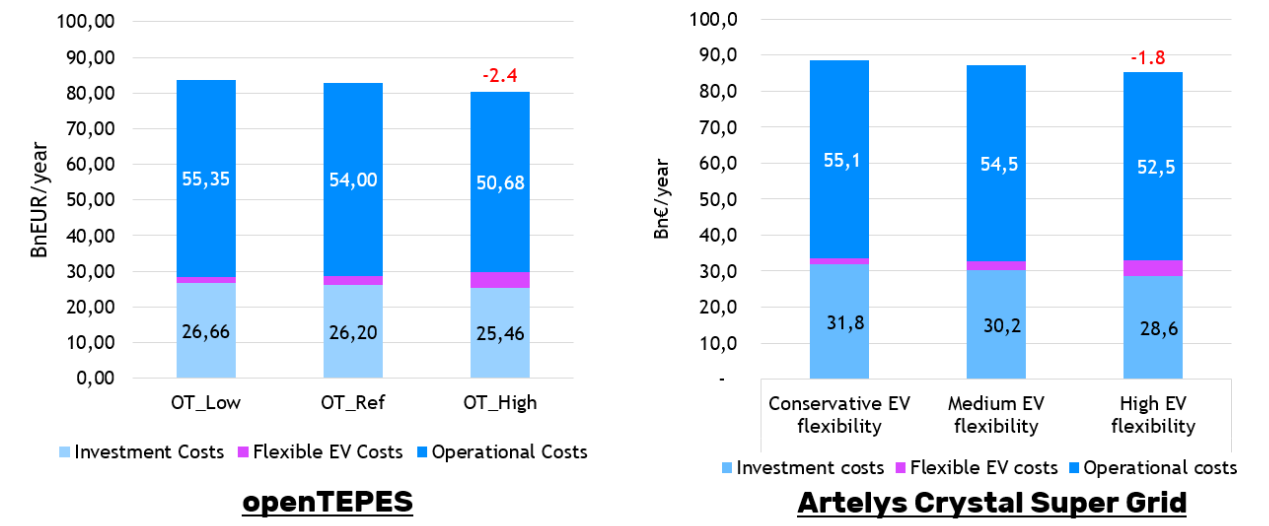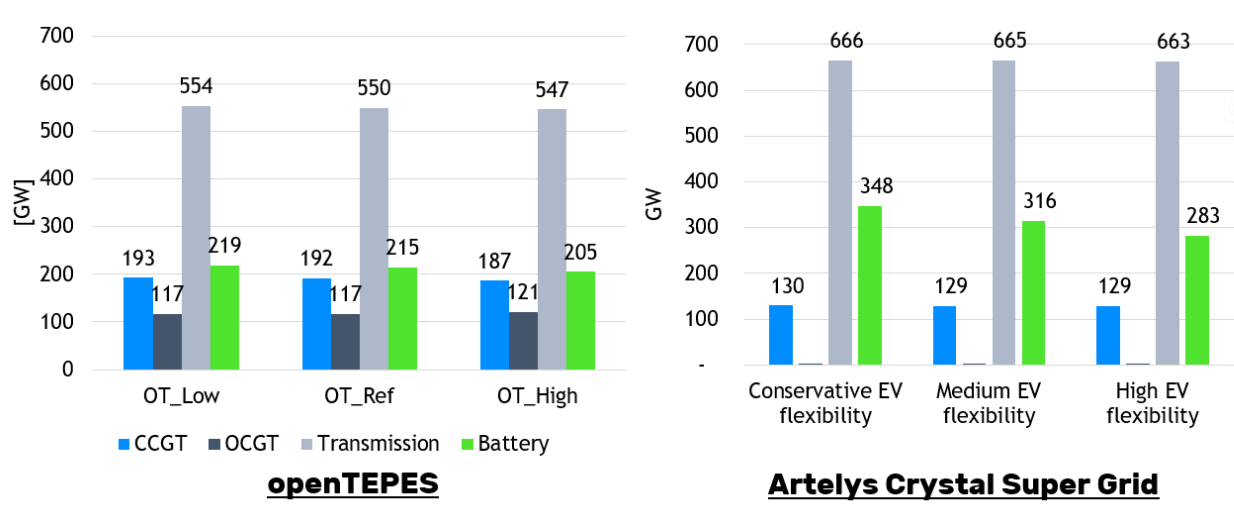Electricity flexibility for the future EU power sector
A net-zero emissions power sector requires higher levels of electricity flexibility. But what is the most cost-effective way of providing electricity flexibility? When and where is it more cost-effective to invest in transmission grid upgrades or battery storage? To what extent does the implementation of smart charging of electric vehicles lower investment costs?
What if we could sit down with Europe’s most advanced modellers and ask them to draw a picture of the future EU energy system? Every one of them would draw a slightly different picture. What’s more, some pictures would resemble one another, while others may look completely different. What are the biggest differences between these pictures and why? When do models show different results and why? This is the main focus of this series of articles and the first one is dedicated to transmission and storage infrastructure for flexibility in the power sector.
What is electricity flexibility?
A well-balanced electricity system implies that electricity generation, consumption, and transmission are harmonized to ensure a reliable energy supply while preventing the risk of outages. In 2021, the flexibility requirements of the EU electricity system was at 11% of demand [1]. Flexibility requirements capture the need for power systems to adapt to the variability of demand and renewable energy production by increasing or decreasing output. This flexibility can be supplied by a variety of solutions, including transmission grid, dispatchable power plants like gas or hydrogen combustion turbines, battery storage, demand response, and flexible new demand such as electrolyzers.
What plans are in place for developing electricity flexibility in the future?
The EU set the target of having 42,5% of its energy come from renewable sources by 2030, which implies that the share of renewables in electricity generation needs to increase above 60% [2]. The EU set an electricity interconnection target of 15% for 2030 [3], meaning that at least 15% of the electricity in every country can be transported to neighbouring countries.
While no set targets are in place for storage technologies, the Commission has conducted a model-based analysis that shows the required electricity flexibility for reaching climate neutrality in 2050 [1]. Specifically, the analysis shows that the flexibility requirements are expected to increase to 24% of total EU electricity demand in 2030 and 30% (2189 TWh) in 2050. These flexibility requirement increases are mostly driven by the expected deployment of variable renewable energy sources like solar PV and wind.
The link between infrastructure needs and demand-side flexibility
The European Climate and Energy Modelling Forum is hosting a model intercomparison exercise to investigate pathways to climate neutrality in the EU by 2050. At the core of this exercise, integrated assessment models and energy supply models are used to develop alternative pathways to achieve climate neutrality in Europe, but these models do not represent electricity flexibility requirements well. To complement this analysis, Comillas Pontifical University and Artelys have conducted a more detailed analysis to understand the trade-offs between infrastructure upgrades, demand-side response, and storage investments with the models openTEPES1 and Crystal SuperGrid2.
This analysis is performed with each model by simulating variants of a scenario derived from the Distributed Energy scenario from the Ten-Year Network Development Plan (TYNDP) report [4]. As ENTSO-E mentions, “Distributed Energy envisions a pathway driven by deep structural system change engaged by the consumers’ willingness to participate in achieving energy autonomy and carbon neutrality by 2050. This translates into a way-of-life evolution (prosumers), decentralized drive towards decarbonization as well as smart sector integration. “. It must be noted that this scenario is close to but not fully carbon-neutral, although modelers expect that this does not affect significantly the nature of the results presented below.
In order to get robust results, the modelers harmonized their assumptions for modelling the reference scenario and performed independently their analyses on the effect of flexibility on infrastructure in 2050, at an hourly resolution. Both models are flexible enough to adapt to a common way of representing the power sector. Modelers agreed on the details of the modelling for instance, the technologies considered and the number of nodes per country (one in this analysis, although both openTEPES and Super Grid could be configured to have multiple nodes, when data is available).
After Crystal Super Grid and openTEPES were calibrated to match the energy mix portrayed in the reference scenario (to the extent of what is possible with available scenario data), with a specific focus on the energy generation, transmission, and storage capacities and level of production projected for 2050, they ran three variants on the amount of flexibility provided by electric vehicles (EVs). Indeed, accounting for the time of connection of EVs to the charging station and the quantity of electricity they need to consume for charging their batteries for each charging session, electric vehicle charging can provide flexibility to the electricity system depending on how the charge is managed.
In this analysis, three types of charge were represented: immediate charging (EVs start charging as soon as they are connected to the charging station), smart charging (EVs optimise their charge during the period they are connected to the station, depending on the electricity price) and vehicle-to-grid (Evs optimise their charge during the period they are connected to the station, depending on the electricity price and can supply electricity back to the grid). The variants simulated assume a different share of each charging behaviour, from the less flexible (conservative flexibility) to the most flexible (high flexibility) as shown in Table 1.
| Scenario name | Charging behaviour distribution | ||
| Immediate charging | Smart charging | Smart+Vehicle-to-grid | |
| Conservative flexibility | 43% | 55% | 2% |
| Medium flexibility (Reference run) | 34% | 60% | 6% |
| High flexibility | 12% | 68% | 20% |
Table 1. Charging behaviour assumptions in scenarios
For each of these variants, investment in flexibility, in particular cross-border interconnections, gas turbines, and utility scale batteries are re-optimised so that the effect of demand-side flexibility can be assessed in terms of avoided investments.
1 OpenTEPES is an open-source energy system optimization model. It calculates the least costly configuration of renewable energy generators, energy storage systems and transmission lines which satisfy a given demand assumption at an hourly time resolution for a given year.
2 Crystal Super Grid is a web-based multi-energy systems modelling and optimisation tool. Modelling wise, it is similar in nature to openTEPES, although specific models and total scope differs. In particular Super Grid can be used at a sub-hourly granularity, for pathway optimisation
of investments, and includes modules for electricity, gas, hydrogen, heat, CO2, among others. The model METIS, used in the analysis by the European Commission is an instance of Crystal Super Grid with specific data and additional models.
What is the impact of demand-side flexibility in system costs and planning?
Disclaimer: these are intermediate results from Comillas and Artelys. The full report has not yet been submitted although main messages can already be derived from these results.
The results obtained with both openTEPES and Crystal Super Grid show that the development of EV flexibility is cost-effective for the system in 2050. The additional costs for demand-side management (e.g. smart meter installed in households) are more than compensated by the economies done in investments in centralised flexibility and yearly operational costs. The graphs below show a yearly benefit of around 2 bn€/yr at the European level, for both models.

Figure 1. Yearly costs of the EU system in 2050 for the scenario considered, for each variant on EV flexibility level.
The economies obtained are of the same magnitude with both models although they seem to be of slightly different nature, with a more significant reduction of investment costs in Super Grid and a higher reduction of operational costs in openTEPES, although both are reduced in both models.
In more detail, both models show that higher V2G and smart charging penetration levels do not affect the resulting cross-border transmission capacities, gas turbines and peakers’ installed capacities.

Figure 2. Capacities of optimised technologies in the EU, in 2050, for the scenario considered, for each variant on EV flexibility level.
The main impact of V2G is on centralized storage investments, with a reduction of 65 GW at EU level in Artelys Crystal Super Grid and a 14 GW reduction at EU level in open TEPES between the conservative and high EV flexibility scenarios.
Overall, the level of flexibility provided by EV has major impacts on centralized storage investments (utility-scale battery capacities) and do not affect cross-border transmission capacities, gas turbines and peakers’ installed capacities.
The differences in EV modelling assumptions between openTEPES (which considers a higher flexibility provided by Electric Vehicles) and Super Grid leads to different uses of flexible technologies (DSR and OCGT) according to both models. However, both models produce results that are in line regarding the impacts of EV flexibility on the system functioning.
What do you think?
This article aims to start a public discussion. How do you think the trade-offs between centralised storage and demand-side flexibility will or should play out? Do the futures envisioned by the models fit your expectations, or do you see things differently? Please add your comments to the discussion forum.
Data Availability
The results can be downloaded from the ECEMF Scenario Explorer under an open CC-BY-4.0 license.
References
- Koolen, D., De Felice, M. and Busch, S., Flexibility requirements and the role of storage in future European power systems, EUR 31239 EN, Publications Office of the European Union, Luxembourg, 2023, ISBN 978-92-76-57363-0, doi:10.2760/384443, JRC130519.
- European Commission, 2023. European Green Deal: EU agrees stronger legislation to accelerate the rollout of renewable energy. Retrieved from https://ec.europa.eu/commission/presscorner/detail/en/IP_23_2061
- European Commission, 2023. Communication from the Commission to the European Parliament, the Council, the European Economic and Social Committee and the Committee of the Regions, Powering a climate-neutral economy: An EU Strategy for Energy System Integration. (COM 2020) 299)
- ENTSO-E & ENTSOG, 2023. Ten-year Network Development Plan 2022: Scenario Report. Available at: https://2022.entsos-tyndp-scenarios.eu/wp-content/uploads/2022/04/TYNDP2022_Joint_Scenario_Full-Report-April-2022.pdf


